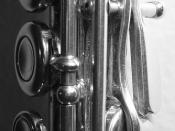This very modern piece is somewhat atonal, as there are distinctions in sections of the piece of which are grounded in F# major/Eb minor (rel-min.) due to an abundance of accidentals. The title suggests it is played 'very slowly' which brings out specific moods to the piece.
The 'musical journey' of the moods in the piece play out as; eeriepeaceful/reminiscentsecretivegradual lead to a climatic pointclimax-sectioned to both instruments downward calming motionpeaceful/reminiscent returnsbreaks away into the distance. The moves free-flowingly and progresses many emotional outcomes.
The melody is shared among the two instruments, and they are distinctively different to each other. The Althorn's melody starts the piece with expression; it moves fairly smoothly and expresses the eeriness mood with the piano's repeated rhythmic bass motive underneath it. This melody is then repeated up a minor 3rd at bar 5. The horn then has an ongoing melodic line which identifies the lead up to the climatic point at bars 8-9, the main climatic point at the end of bar 9 and the upward motion to nothingness at bars 12-14.
This particular melody is accompanied by the piano part which either compliments the horn or similarly moves with it.
The other shorter melody belongs to the piano which plays solo at bars 3-5 and 11-12 with the exact same melodic line. This melody consists of a moving motive over clusters of chords that move rhythmically similarly together. It is also marked to be played smoothly and with expression which brings out the main mood; this particular motive recites the peaceful/reminiscent moods of the piece.
Also with the accompanying piano part, Hindemith has used two bass lines at some points to depict different tone colours which cleverly represent the 'separate' sections of the piece the beginning and end (bars 1-3 and 13-14).


